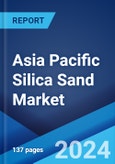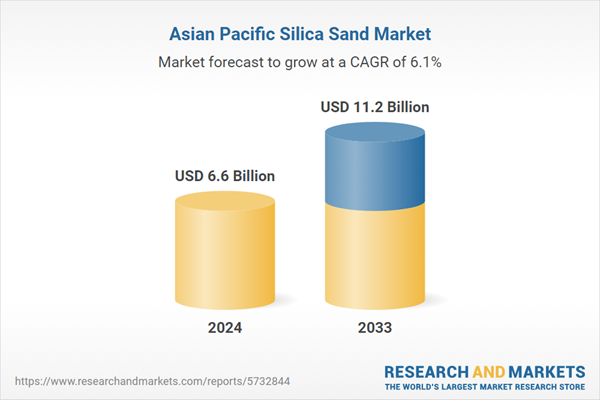Silica sand, also known as industrial sand, is a granular material composed of silicon dioxide (SiO2), as feldspar, clay, and iron oxides. It is a naturally occurring form of quartz that is abundantly found on Earth. It offers enhanced hardness, low impurity content, resistance to weathering, and low conductivity. Besides this, it provides improved transparency, strength, and resistance to heat and chemicals. As it is widely employed in foundry casting and water filtration, the demand for silica sand is rising in the Asia Pacific region.
At present, the increasing utilization of silica sand in the oil and gas industry in hydraulic fracturing (fracking) operations is contributing to the growth of the market in the Asia Pacific region. In addition, the rising adoption in the foundry industry for producing precise and high-quality metal castings is propelling the growth of the market. Apart from this, the growing demand for high-purity silica sand in manufacturing photovoltaic panels and silicon-metal composite materials is offering a positive market outlook in the Asia Pacific region. Besides this, the rising employment of silica sand in the automotive industry for producing specialty glass is strengthening the growth of the market. Furthermore, the increasing demand for silica sand due to the thriving manufacturing sector in the region is bolstering the growth of the market.
Asia Pacific Silica Sand Market Trends/Drivers
Increasing adoption in the construction industry
There is a rise in the adoption of silica sand due to rapid urbanization and increasing investments in residential, commercial, and infrastructure projects across the region. People are increasingly preferring renovation in households on account of their inflating income levels and improving living standards. Moreover, silica sand is an essential component in concrete and mortar mixes that assists in providing strength and durability to the structures in the Asia Pacific region. Constructors are increasingly utilizing silica sand in construction activities to enhance the workability of a building. Besides this, there is an increasing focus on sustainable construction practices, such as green buildings and eco-friendly materials among the masses, which, in turn, is catalyzing the demand for silica sand, as it is a natural and readily available resource that is widely utilized as a sustainable material in construction in the region.Rising utilization in environmental remediation and waste management
Governing agencies of different countries in the Asia Pacific region are rapidly adopting silica sand in environmental remediation and waste management applications to reduce environmental pollution. They are also utilizing silica sand as a bedding material for landfill liners to prevent the leakage of contaminants into the surrounding soil and groundwater. Moreover, governing authorities in the region are implementing stringent environmental regulations and prompting industries to adopt more sustainable practices in the Asia Pacific region. They are also implementing policies and guidelines to address soil and ground water contamination and encouraging proper disposal of waste. Apart from this, silica sand is utilized in soil remediation projects to treat contaminated soil and groundwater by absorbing and removing pollutants. It acts as a medium for soil vapor extraction and assists in the removal of volatile organic compounds (VOCs) and other contaminants. It is also used in wastewater treatment processes in the region to enhance filtration and remove suspended solids, turbidity, and organic matter from wastewater, in turn providing cleaner and safer water. It is employed as a filtration medium in various treatment systems, such as rapid sand filters and multimedia filters. . People are increasingly focusing on consuming safe water to prevent diseases due to environmental concerns about waste management among individuals in the Asia Pacific region.Asia Pacific Silica Sand Industry Segmentation
This report provides an analysis of the key trends in each segment of the Asia Pacific silica sand market report, along with forecasts at the regional and country levels from 2025-2033. The report has categorized the market based on end use.Breakup by End Use
- Glass Industry
- Foundry
- Hydraulic Fracturing
- Filtration
- Abrasives
- Others
The report has provided a detailed breakup and analysis of the market based on the end use. This includes glass industry, foundry, hydraulic fracturing, filtration, abrasives, and others. According to the report, glass industry represented the largest segment.
Silica sand is widely utilized in the glass industry for producing various glass products, such as bottles, containers, flat glass, fiberglass, and specialty glass in the Asia Pacific region. The rising adoption of silica sand, as it assists in enhancing the transparency, strength, and thermal resistance of glass, is contributing to the growth of the market. There is a rise in the utilization of glass in construction activities, architectural designs, and packaging. Additionally, silica sand is widely utilized in the production of fiberglass, which is further useful in the manufacturing of insulation, roofing materials, composite materials, and other structural components. It is also used in the automotive, solar energy, and electronics sectors for manufacturing various glass-related components with enhanced durability. In addition, there is a rise in the demand for silica sand due to the increasing focus on energy-efficient buildings in the region. Moreover, the growing demand for glass containers and packaging materials in food and beverage (F&B), pharmaceutical, and cosmetics industries is positively influencing the market. Furthermore, the rising utilization of glass containers manufactured from silica sand, as it provides enhanced chemical stability for storing and preserving various substances is bolstering the growth of the market.
Breakup by Country
- China
- India
- Malaysia
- South Korea
- Japan
- Australia
- Others
The report has also provided a comprehensive analysis of all the major regional markets, which include China, India, Malaysia, South Korea, Japan, Australia, and others.
China held the biggest market share as it has considerable silica sand resources with cost-effective rates. In addition, the rising utilization of silica sand in the foundry casting and glass industry is contributing to the growth of the market in the country. Apart from this, the increasing infrastructure development and real estate projects are supporting the growth of the market in China. In line with this, the growing demand for silica sand due to the increasing industrialization and urbanization is positively influencing the market. Besides this, technological advancements in silica sand mining are bolstering the growth of the market in China. Additionally, the rising number of shale gas exploration activities is propelling the growth of the market in the country.
Competitive Landscape
Key players in the Asia Pacific region are engaging in silica sand mining and extraction operations to obtain raw materials. This comprises identifying suitable deposits, obtaining necessary permits, and employing mining techniques to extract silica sand from the Earth. In addition, companies are employing advanced techniques, such as washing, drying, crushing, sorting, and grading to remove impurities, enhance purity and quality, and achieve desired specifications. Apart from this, various manufacturers in the region are focusing on introducing specialized grades of silica sand with specific particle size distribution, purity levels, and chemical properties to cater to the demand in various end-use industries, such as glass, foundry, and fracking. Additionally, several companies are focusing on implementing measures to minimize environmental impact during mining, processing, and transportation activities in the Asia Pacific region. Furthermore, they are investing in quality control measures to ensure the consistency and reliability of their products, which is positively influencing the market.The report has provided a comprehensive analysis of the competitive landscape in the market. Detailed profiles of all major companies have also been provided.
- Chongqing Changjiang River Moulding Material (Group) Co. Ltd
- Diatreme Resources Limited
- JFE Mineral Company Ltd.
- Mangal Minerals
- Mitsubishi Corporation
- PUM Group
- Raghav Productivity Enhancers Limited
- Rock Energy International
- TOCHU Corporation
- VRX Silica Ltd
- Xinyi Golden Ruite Quartz Materials Co., Ltd.
Key Questions Answered in This Report
1. How big is the silica sand market in the Asia Pacific?2. What factors are driving the growth of the Asia Pacific silica sand market?
3. What is the forecast for the silica sand market in the Asia Pacific?
4. Which segment accounted for the largest Asia Pacific silica sand end use market share?
5. Who are the major players in the Asia Pacific silica sand market?
Table of Contents
Companies Mentioned
- Chongqing Changjiang River Moulding Material (Group) Co. Ltd
- Diatreme Resources Limited
- JFE Mineral Company Ltd.
- Mangal Minerals
- Mitsubishi Corporation
- PUM Group
- Raghav Productivity Enhancers Limited
- Rock Energy International
- TOCHU Corporation
- VRX Silica Limited and Xinyi Golden Ruite Quartz Materials Co.
- Limited
Methodology

LOADING...
Table Information
| Report Attribute | Details |
|---|---|
| No. of Pages | 150 |
| Published | February 2025 |
| Forecast Period | 2024 - 2033 |
| Estimated Market Value ( USD | $ 6.6 Billion |
| Forecasted Market Value ( USD | $ 11.2 Billion |
| Compound Annual Growth Rate | 6.1% |
| Regions Covered | Asia Pacific |
| No. of Companies Mentioned | 11 |









